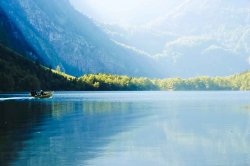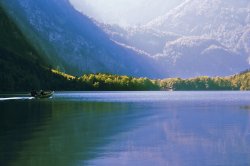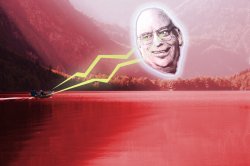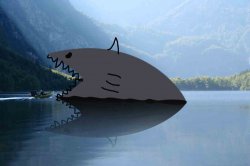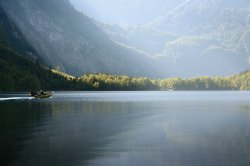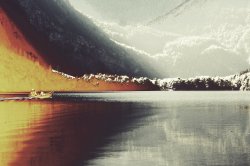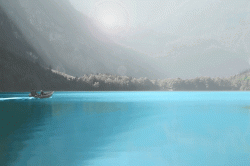What do I need to do to it to make it truely, say for example, print ready?
Cheerrsss!! SpaceMagic
Contrast attracts the eye in a photo. In this shot, which is dark overall the eye is drawn to the bright -- empty

-- spot on the lake then up into the lighter background and up and out of the photo. What I suspect you intended as the center of interest -- the boat -- is off to the side hidden in the shadows. Better if you had waited for the boat to reach that bright patch of water in the lake; something to keep in mind next time: 1) decide on a center of interest / focal point for your shot, 2) make it contrast most (tone, color, size, sharpness) with the background tone, 3) compose it to create an interesting path in the photo to it, 4) eliminate distractions from it.
Here there's no magic trick which will help the boat pop out of the shadows but you can reduce the pull of the background by making it darker. I do this in Photoshop by duping the background layer, setting the mode of the dupe layer to "multiply" then adding a black filled mask over it. By selectively erasing the mask in the background it can be made darker and more saturated. The same technique can be used with "screen" mode to lighten areas like the boat selectively. These adjustment layers are similar to "burn" and "dodge" in their net effect but they add saturation rather than more or less gray to the existing color. A dupe masked "hard light" or "soft light" layer can also be added to adjust contrast. A little goes a long way with those two so it's necessary to scale back the effect with the opacity slider on the dupe layer.
The other main thing you can do to improve appearance is to sharpen with USM. How much to sharpen varies with size of print and subject matter but it should be done as the last step before printing or saving a copy of the unsharpened master edit file. USM increases contrast between color and tonal borders which tricks our eyes into thinking the borders are sharper. There are three numerical controls: amt, radius, threshold.
Radius controls how far on either side of the transition gets sharpened. 2. to 1.5 is a good range to start with.
Threshold controls how much difference in color/tone there must be before the sharpening will be applied. 0 sharpens everything. Above 5 only very contrasty transitions (e.g. eyelashes surrounded by skin) will get sharpened. 0 is good for landscapes like your shot. 2-4 for portraits.
Amount controls the strength of the sharpening. There's a ying/yang relationship between Amount and radius. For example I use 500, .2, 0-3 for screen images to crisp them up, but USM in the range of 150-200,.5--1.0, 0-3 for inkjet prints where the borders are less well defined due to the random overlapping of the 8 color dots.
As with most things USM is subjective and the best way to learn what works best for you is to try various methods on the same image and compare the results at various viewing distances. Viewing distance and output method are two key variables. In general the bigger and further away an image is viewed the most USM it needed to retain the overall contrast and impact of a smaller copy from reading distance. When making large prints its a good practice to make a small test of a cropped section of the full size up-res file at various USM settings and then view the tests from the same distance the full size print will be viewed.
Chuck Gardner
http://super.nova.org/DPR/



